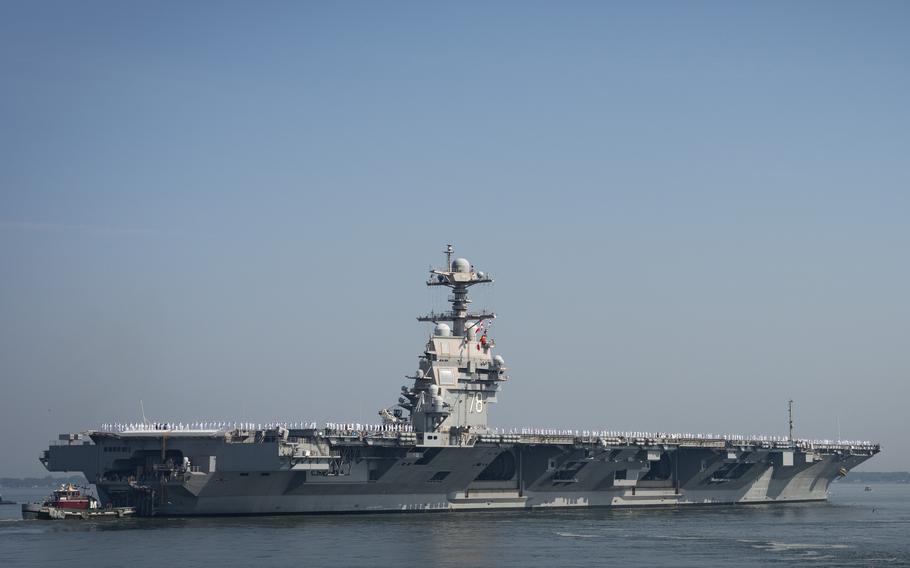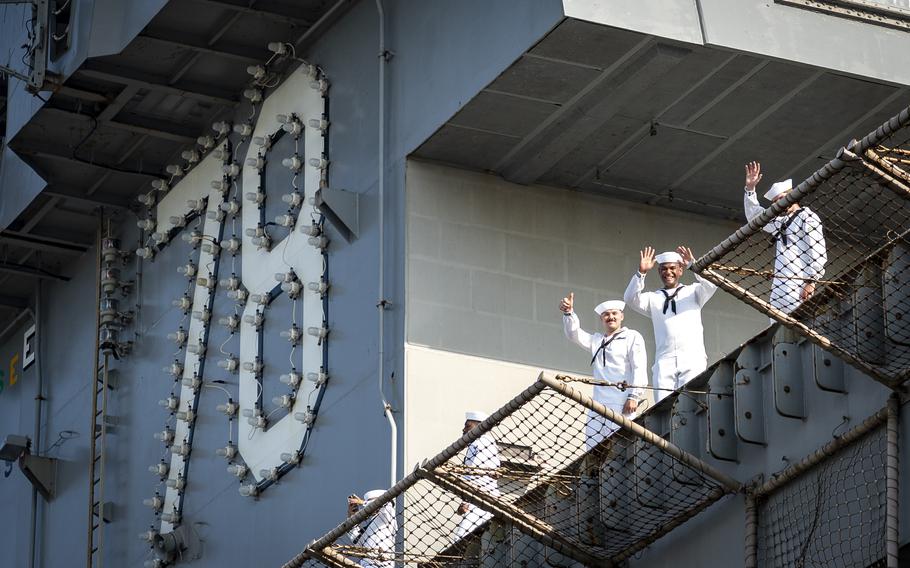
The aircraft carrier USS Gerald R. Ford departs Naval Station Norfolk, Va., on June 24, 2025, for a deployment to the European theater. (Anderson W. Branch/U.S. Navy)
WASHINGTON — The aircraft carrier USS Gerald R. Ford and the ships that make up its strike group deployed Tuesday to the European theater, where it could move closer to Israel.
“We are America’s away team,” said Rear Adm. Paul Lanzilotta, commander of the strike group. “As we say farewell to our loved ones today, it is with the knowledge that we are taking the watch and protecting our America values of freedom, prosperity and security on the high seas through sustained operations. Our force is the physical reality of the notion of ‘peace through strength’.”
The Ford and destroyer USS Bainbridge left Naval Station Norfolk, Va., and will meet up with destroyer USS Forest Sherman, which deployed in May. The strike group — a force of 4,500 sailors — also includes destroyers USS Winston S. Churchill, USS Mitscher and USS Mahan, and nine aviation squadrons.

Sailors aboard the USS Gerald R. Ford wave to the pier prior to the ship’s departure from Naval Station Norfolk, Va., on June 24, 2025, for a deployment to the European theater. (Anderson W. Branch/U.S. Navy)
The Ford is sailing to the U.S. European Command — or the 6th Fleet — which includes the waters around Europe and Africa, as well as parts of the Arctic. But the strike group could be directed elsewhere, such as the Eastern Mediterranean and closer in proximity to Israel and Iran, according to Lanzilotta.
“The world around us evolves as we man the watch and as we do our jobs. Our mission is always the same: We operate on the high seas. We bring power projection. We defend ourselves when needed. We are ready to do humanitarian assistance if we need to...This is the exact naval mission package that you want to go over the horizon,” he said.
The deployment has been scheduled for months, though the strike group’s departure coincides with a nearly two-week conflict in the Middle East in which Israel and Iran had exchanged almost daily bombing raids.
The U.S. joined the attacks over the weekend, employing more than 125 aircraft — some used as decoys — and more than a dozen bunker-buster bombs to attack three nuclear sites in Iran, the Pentagon said Sunday.
Iran on Monday launched missile attacks on U.S. forces at al Udeid Air Base in Qatar in retaliation. President Donald Trump said Iran gave advance notice before firing 14 missiles. Thirteen of the missiles were intercepted and there have been no casualties reported.
Later Monday, Trump announced a ceasefire deal had been reached. But the deal initially faltered Tuesday morning as explosions boomed and sirens sounded across northern Israel. An Israeli military official said two Iranian missiles were intercepted, The Associated Press reported.
“Israel is not going to attack Iran,” Trump wrote on Truth Social. “All planes will turn around and head home, while doing a friendly ‘plane wave’ to Iran. Nobody will be hurt, the ceasefire is in effect!”
The Ford strike group, commanders said, have spent the past several weeks working with the USS Harry S. Truman. The aircraft carrier returned June 1 from the Red Sea, where it combatted drones and missiles launched by Iran-backed Houthi rebels. The Houthi agreed to stop targeting ships — commercial and military — after the U.S. launched a nearly seven-week campaign, striking Houthi facilities in Yemen.
“We went over everything. Every little detail — what our adversaries are doing, how we counter that,” said Capt. David Dartez, commander of the strike group’s air wing.
The USS Carl Vinson and its carrier strike group are already operating in the area of U.S. Central Command, which oversees military operations in the Middle East. The Vinson operated in the Indo-Pacific region from November to late March before being ordered to the Middle East.
The USS Nimitz carrier strike group was also pulled last week from an Indo-Pacific deployment to support U.S. forces in the Middle East amid the ongoing strikes between Israel and Iran. It is unclear whether the U.S. will keep three carrier strike groups in close proximity to Israel and Iran.